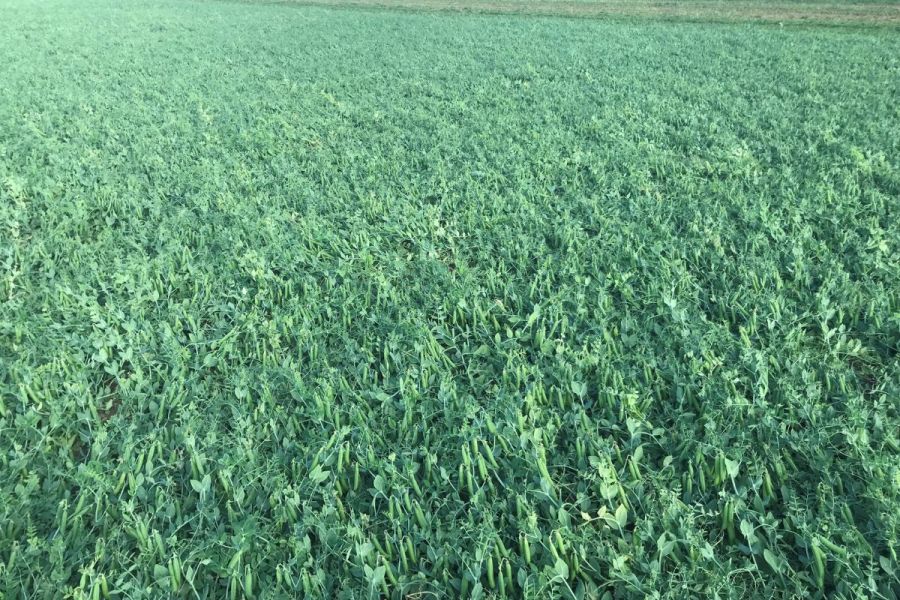Arguably the biggest cause of financial losses in vining peas, bean seed fly can also decimate beans, but little is known of this pest’s behaviour and there’s no chemistry to curtail it. CPM investigates research putting this fly under the spotlight.
“The project offers a lot of potential for advancing IPM strategies and is really positive progress against this pest.”
By Melanie Jenkins
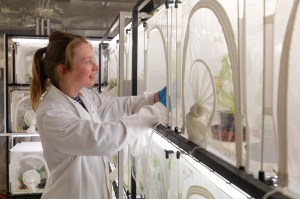
Becca McGowan, a PhD student at the University of Warwick, has spent the past three and half years researching the bean seed fly.
Aside from anecdotal evidence, there are big gaps in research into the pest known as bean seed fly. And with no chemistry available to control it, there’s no other option but to take integrated pest management to the next level, which is just what Becca McGowan, a PhD student at the University of Warwick, has spent the past three and half years researching alongside PGRO.
Actually comprising of two very closely related species, Delia platura and Delia florilega, the bean seed fly is a generalist pest that will feed on a large range of plants including onions, brassicas, lettuces, maize, cucumber and legumes such as peas and beans, explains Becky Howard of PGRO.
“These pests show low levels of activity over winter, but we tend to see a peak in adult activity from mid-April onwards. Adults then lay eggs in soil and once the larvae hatch, these feed on the seeds and stems of germinating crops which can result in patchy establishment or even total crop failure.”
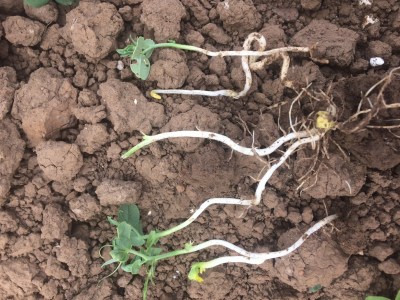
In peas, larval damage is harder to spot but seeds can show signs of tunnelling.
Symptoms of activity in beans include damage to the growing point of emerging seedlings, lack of cotyledon development, no true leaves and low percentage emergence, explains Becca. “In peas, larval damage is harder to spot. If you look at seeds, you can see tunnelling but emerged plants can still look healthy.”
It’s this impact on emergence that makes the bean seed fly such an issue, adds Becky. “If the pest reduces establishment, this can result in significant losses and can impact the maturity of vining peas across a field, which is used as a key indicator of harvest date.”
PGRO sees varying levels of damage each year, depending on conditions, she says. “This can be down to recent cultivations, as well as high levels of organic and green material. And the pests are attracted by the exudates of seeds as they imbibe water from recently disturbed soil.
“The highest risk tends to be to later drilled crops, such as green beans planted in May and vining peas going in throughout June, in some areas,” she explains. “There’s potential for a significant number of crops to be at risk.
“Although it’s a widespread pest, it tends to be relatively regional, with some areas more badly affected and this varies a lot year-on-year,” adds Becky. “A lot of the work PGRO has done looking at the pest has been in the Yorkshire and Lincolnshire Wolds and in Warwickshire.”
The big problem growers face with this pest is that its behaviours are not that well understood and there’s no pesticide available for UK growers to control it, says Becca. “There’s neither chemical nor seed treatment control, so to tackle it we have to look at a more integrated approach, monitor the fly and research more sustainable solutions to incorporate into IPM strategies.”
Becca’s PhD project is looking at tackling the pest from four angles. The first aspect of the AHDB and PGRO funded research has been to look into the overwintering behaviour of the bean seed fly as little was known about this, and the assumption has been that it goes into diapause – a state of insect hibernation. “Similar species, like the cabbage root fly and onion fly, go into this type of hibernation,” explains Becca. “To be able to investigate the second objective of the project – forecasting spring emergence – we had to understand this overwinter activity.”
The two other objectives have involved looking at cultural strategies to prevent infestation and to effectively monitor the pest. “We created a culture of the bean seed fly – essentially a collection of the insects obtained from fields in the rearing unit – and looked to answer questions on their behaviour. Firstly, we studied whether the flies went into diapause and if so, how long they are in it. We also looked at how they developed in real conditions by observing egg development in the field to help us work out how we could forecast more reliable adult fly emergence.”
From this, Becca was able to determine that the bean seed fly actually behaves quite differently to other closely related species. “Unlike the cabbage root fly and onion fly, we found that only a small percentage of the bean seed fly would go into diapause, with the majority slowing their development but continuing to be active in the field. This meant it was necessary to find a different way of forecasting spring emergence of the adults, and this is something I’m just finishing experiments on.”
Because bean seed flies are insects, their development is dependent on temperature, explains Becca. “Based on five years of Warwick Crop Centre data from water traps, we can predict spring emergence of the pest in the field using the accumulation of day-degrees above a base temperature of 3.9°C. For example, the model predicts that 50% of the spring generation will have emerged once 313 day-degrees have been accumulated from 1 January.”
At a constant temperature of about 20˚C, it takes two days for bean seed fly eggs to hatch. Larvae will then feed for 14 days and can eat organic material as well as seeds, which is why they can survive in higher organic material soils before seeds are drilled, she explains.
“Depending on temperatures, you can choose whether to sow before or after the expected date of peak emergence,” she explains. “Generally, with beans and peas, once the cotyledons separate the plant can withstand larval feeding, so the pest often causes most issues before this point.”
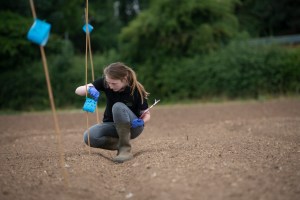
Field monitoring trials investigated whether traps containing a blue lure are more effective at catching bean seed flies than those without.
In the field, Becca undertook both monitoring and management trials, which included investigating whether blue sticky traps containing a lure are more effective than those without. “We also looked at the impact of the orientation of traps and their effectiveness depending on how long they were left out for,” she explains.
The results of these experiments were that traps with a lure attracted more bean seed flies – almost three times as many compared with those without, says Becca. “Horizontal sticky traps were also more effective at catching the pest than curly sticky traps, and the less time the trap is in the field the more efficient it is. Leaving a trap in for one to two days is ideal, otherwise you catch too many other species and it gets hard to identify the bean seed fly.”
To explore management strategies, Becca produced replicated field trials looking at whether bringing cultivations forwards by seven days ahead of drilling would reduce fly damage and if covering soils with a fine mesh on the day of cultivations and sowing would also lessen the impact of the pest. “The current literature says that ground with high organic material, that has been recently cultivated, attracts adult bean seed fly females to lay their eggs. So in theory, if cultivations happen at the time of sowing, more flies will be attracted to the plot to lay their eggs.”
The trials were undertaken in 2021 and 2022, but of the seven trials only one demonstrated that delayed cultivations reduced fly damage. And this was the same for the trial on covering cultivations. “There was a significant effect but there were considerably more flies seen in this trial, so we’re now looking at why this might be. However, it does show promise that delaying cultivations or covering the crop could be an option.”
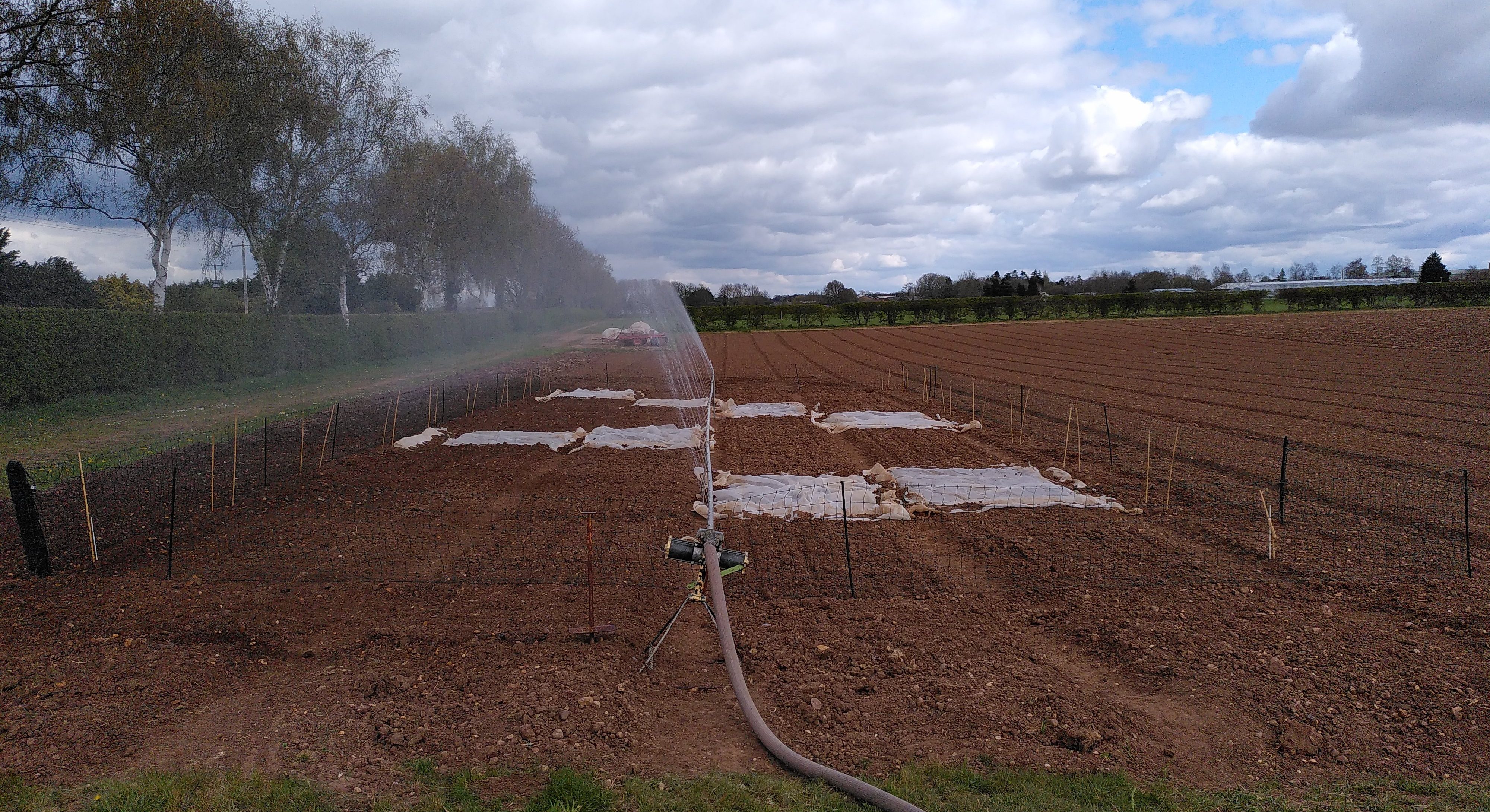
Replicated field trials explored whether delaying cultivations by seven days before drilling would reduce fly damage.
PGRO has been closely involved with the research into cultivation techniques, says Becky. “With trials suggesting that delayed drilling could limit fly damage, by monitoring the pest, it should be possible for you identify where the highest risk areas are and perhaps change your sowing date accordingly.”
There’s already a lot of guidance on cultivation and drilling, which includes creating a stale seedbed , but PGRO also advises ensuring all organic material has been allowed to fully die back before planting, says Becky. “Get on top of weed management and make sure cover or root crops are killed off early. This is more difficult with root crops so maybe consider selecting fields that are lower risk.”
Becca has now finished all of the field trials and is in the final stages of practical work before she starts writing up her PhD. She will then fully analyse the results of her project which will help develop a forecasting tool. “We’re looking at whether the flies are laying eggs if temperatures are low over winter. And what they’re doing during the summer, as some evidence suggests they might go into aestivation – summer dormancy – when temperatures are too high, because this could also impact forecasting their behaviour.”
Being able to effectively monitor and forecast the pest will allow growers to make decisions on when to plant their crops, says Becca. “The project won’t be a silver bullet against bean seed fly, but it will be a contribution towards an IPM strategy. But at the moment, if you suspect there’s damage from bean seed fly, it’s really beneficial to report this to PGRO as this helps us build a picture of where the pest is and how sporadic it is.”
PGRO continues to explore whether there are any soil applied products which will be effective against the pest, says Becky. “While we look into further management measures, the project offers a lot of potential for advancing IPM strategies and is really positive progress against this pest.”
Flying the flag
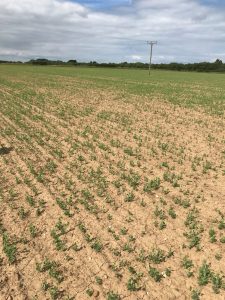
Where fields haven’t been kept clean of weeds, the seedbed has dried out and the next generation of flies were observed emerging from the cracks in early summer.
After three decades of working for cooperative Swaythorpe Growers, Matthew Hayward has seen his fair share of the bean seed fly in pea crops. “In 1998, we had an incredibly wet spring and many of our growers were unable to work their seedbeds until drilling. There was a lot of greening up and big flushes of chickweed and speedwell. Once crops were drilled, we saw a lot of damage and rotten seeds. Anthony Biddle of PGRO came to look at the crops and announced that the issue was bean seed fly. This was because they were attracted to the high level of decaying organic material in the seedbed. And the worst affected patches were where the greenery had been.”
Since then he has seen a repeat of this sporadically for a number of years. “As a result, our growers have generally tried to produce stale seedbeds or have worked soils in early spring, killing any greenery with cultivations,” he explains. “But there are still problems, especially with looser soils.”
Chalky, stony soils is where crop damage has been greatest, says Matthew. “The fly and its larvae can move more easily in these loose soil types. But at the time we noticed this, we still had access to Cruiser (thiamethoxam) seed treatment, which was really effective against the fly.”
Over the years, Matthew observed another pattern building. “One example of this was a year where two cooperative members had adjacent fields of peas. One farmer worked the seedbed early in spring – at the end of March into early April – and then drilled mid-May into a stale seedbed with a Väderstad drill.
“The neighbouring farmer didn’t work his land until two days before drilling. He used the same drill, the identical variety and both fields were planted on the same day.
“The first farmer had the perfect crop with 100 plants/m², whereas the second farmer got 40 plants/m² and consequently a massive reduction in yield. On this occasion both seedbeds were clean which raised another question as to what the attractant was here.”
He has seen other scenarios where pea crops have hardly established where seedbeds haven’t been kept clean of weeds. “The seedbed had dried out and I could see the next generation of flies emerging from the cracks in early summer. And in another case, there was a big bald patch in a crop adjacent to a muck pad as the manure had drawn the flies in.”
Over the past two years, Matthew has seen plot trials where one was worked five weeks prior to drilling, another two weeks ahead and the third, one day before. “These trials have shown that damage levels are massively greater where the seedbed is worked immediately prior to sowing in May, further proving that flies are not only attracted to decaying organic material but also freshly disturbed soils,” he says.
“One thing with this pest is that you might not think you’ve got any damage – the plants might look fine – but approaching harvest and pod filling you may see random plants dying, which coincides with warmer weather and the root being unable to cope due to the earlier damage,” he explains. “In these cases, fusarium foot rot sometimes gets hold and plants easily pull out of the soil.”
Matthew believes that the bean seed fly is the biggest pest for the members of the cooperative. “It’s the greatest cause of financial losses. There are other pests but the potential damage from this one in our area is massive.”
Having worked with Becca on her PhD over the past three years, he’s positive about the value of a forecasting tool to help growers tailor their IPM strategies. “If we can build up a pattern of fly emergence and forecast it accurately, then we can work towards cultivating seedbeds accordingly.”
This article was taken from the latest issue of CPM. For more articles like this, subscribe here.
Sign up for Crop Production Magazine’s FREE e-newsletter here.

